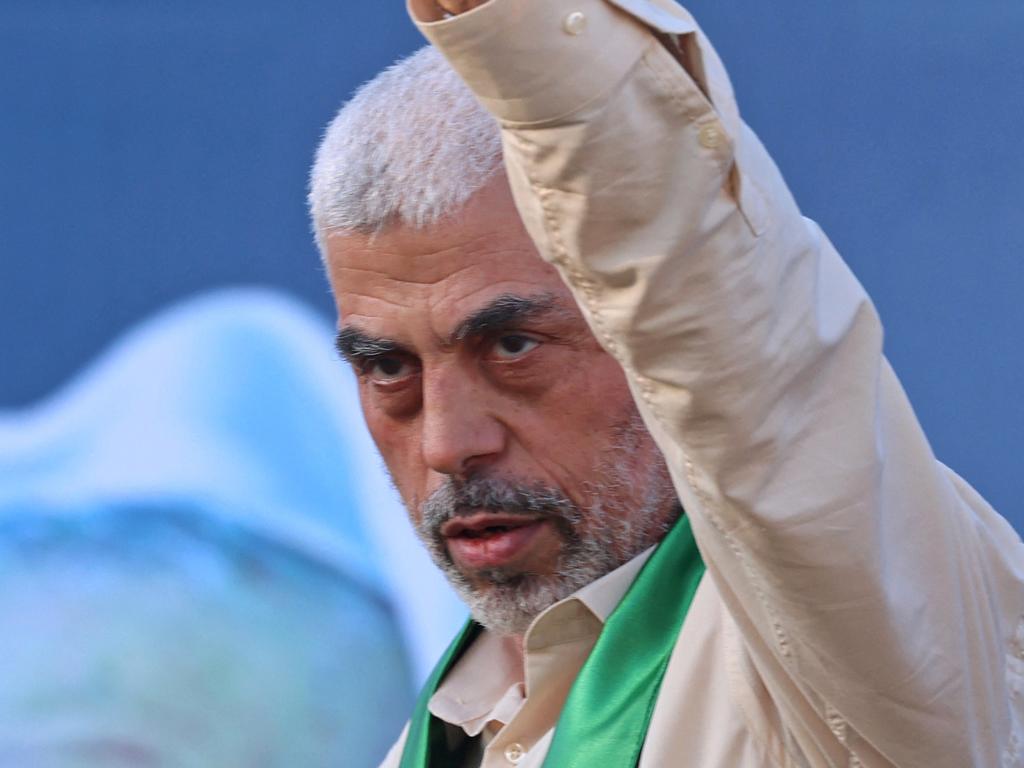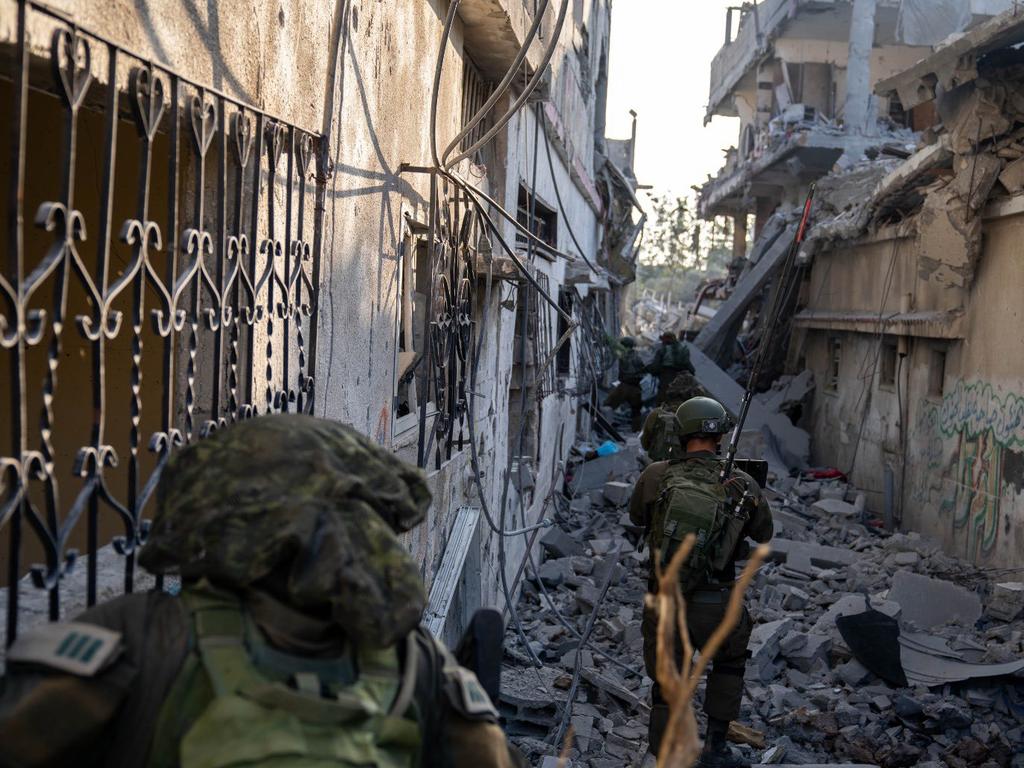Hamas leader Yahya Sinwar surrounded and ‘hiding in his bunker’, IDF says
He’s dubbed Israel’s most wanted and a “dead man walking” — and now he’s trapped “in his bunker”. What do we know about Yahya Sinwar?
Israel said on Tuesday its forces were operating “in the heart of Gaza City” one month after Hamas’s bloody October 7 attacks, as the campaign to crush the Palestinian militants intensifies.
In a televised address from the Kirya military headquarters in Tel Aviv, Prime Minister Benjamin Netanyahu said Israel’s military had reached deeper into Gaza than Hamas ever imagined.
“In the south, the war is moving forward with force that Hamas has never seen,” he said, The Times of Israel reported. “Gaza City is surrounded. We are operating within it, we are deepening the pressure on Hamas every hour, every day.”
The PM said thousands of Hamas terrorists had been killed, both above and below ground, adding the Israel Defense Forces (IDF) had destroyed “countless” Hamas command centres, positions and tunnels.
“Hamas is discovering that we are reaching places they thought we would never reach,” he said.

Hamas leader ‘in bunker’
Yoav Gallant, Israel’s defence minister, underlined the nation’s determination “to destroy Hamas”.
“We are in the heart of Gaza City,” he said.
“Gaza is the largest terrorist base ever built by man. This whole city is one big terror base. Under the ground, kilometres of tunnels connect to hospitals, to schools, they are interconnected. It contains communication rooms, ammunition depots, places to sleep, and everything to serve as a base of terrorism from which the citizens of the state of Israel and IDF soldiers can be harmed.”
Mr Gallant added that Hamas leader Yahya Sinwar “is hiding in his bunker and is without contact with his associates”, although he did not say where the bunker was located.
He stressed “there will be no humanitarian truce without the return of the hostages”.
Mr Netanyahu also said there would be no fuel delivered to Gaza and no ceasefire in Israel’s fighting with Hamas unless the more than 240 hostages seized by the Palestinian militants are freed.
“There will not be a ceasefire without the return of our kidnapped,” he said, adding the message was for “our enemies and our friends alike”.
The PM also issued a stark warning to Hezbollah in Lebanon which, like Hamas, is backed by Iran.
“If Hezbollah makes the choice of joining the war it will be making the mistake of its life,” he said.
IDF spokesman Rear Admiral Daniel Hagari said Israel had struck more than 14,000 targets in the Gaza Strip and destroyed more than 100 tunnel entrances.
“Hamas terrorists tell themselves that there will be a ceasefire,” he said. “There won’t be one. We are moving forward.”
The comments came as the IDF released new intelligence on Sunday it claimed provided further evidence Hamas was using hospitals for terror purposes.

Who is Yahya Sinwar?
The 61-year-old, dubbed Israel’s most wanted and called a “dead man walking” by Mr Netanyahu, orchestrated the terror group’s October 7 massacre alongside Mohammed Deif, the head of Hamas’ military wing, the al-Qassam Brigades.
Sinwar is one of the founding members of the Hamas and its leader within the Gaza Strip, after being secretly elected to that role in 2017. Ismail Haniyeh, who lives in Qatar, is generally considered Hamas’ overall leader.
In the 1980s he founded Majd, Hamas’ internal security organisation and “police” force tasked with tracking Israeli agents.
Sinwar has been arrested three times and after his third arrest in 1988 was sentenced to four life terms in prison for the abduction and killing of two Israeli soldiers.
He spent 23 years behind bars before being released in 2011 as the most senior of more than 1000 prisoners swapped for kidnapped Israeli soldier Gilad Shalit — the highest price ever paid by the Jewish state for the release of one man.
Shalit was captured in 2006 as a 19-year-old corporal and spent five years in Hamas captivity in Gaza.
Upon his release, Sinwar said the experience had taught him kidnapping Israeli soldiers was the only way to free Palestinian prisoners, The Guardian reported.
In 2015, the US government added Sinwar to its blacklist of “specially designated global terrorists”.
“He is considered to be one of the most senior and prominent prisoners to be exchanged, and has called on militants to capture more Israeli soldiers,” the US State Department said at the time.
According to a former interrogator, while in prison Sinwar refused to talk to any Israelis and personally punished those who did, once pushing a person’s face into a makeshift stove.
“He’s 1000 per cent committed and 1000 per cent violent, a very, very hard man,” the interrogator told The Guardian.

One month milestone
Tuesday was a day of commemoration in Israel to mark the grim one-month milestone.
Sobs pierced memorial ceremonies and crowds lit candles while mourning the 1400 dead, including families slain in their homes and young people killed at a music festival, in Israel’s worst attack since its 1948 founding.
Israel has vowed to destroy the Islamist militants over their shock attack, launching a campaign in the Gaza Strip that has killed more than 10,300 people, mostly civilians, said the Palestinian territory’s Hamas-run health ministry.
“There’s not one person not impacted by these horrible attacks,” said 52-year-old Sharon Balaban, one of thousands of Israelis who attended sorrowful memorial events. “Everyone knows somebody who was hurt, killed, murdered or impacted.”

US opposes Gaza occupation
Despite growing calls for a ceasefire, Mr Netanyahu has made clear there will not be one unless the hostages are freed.
He has said Israel would assume “overall security” in Gaza after the war ends, while allowing for possible “tactical pauses” before then to free captives and deliver aid to the besieged territory of 2.4 million people.
However, Washington said on Tuesday it opposed a new long-term occupation of Gaza by Israel.
“Our viewpoint is that Palestinians must be at the forefront of these decisions and Gaza is Palestinian land and it will remain Palestinian land,” said State Department spokesman Vedant Patel.
“Generally speaking, we do not support the reoccupation of Gaza and neither does Israel.”
Israel withdrew from the territory, which it captured in the 1967 Six-Day War, in 2005.
On Tuesday UN human rights chief Volker Turk called the month that followed the attack one marked by “carnage, of incessant suffering, bloodshed, destruction, outrage and despair”.
Since the attack, Israel has relentlessly hammered Gaza with more than 12,000 air and artillery strikes and sent in ground forces that have effectively cut it in half.

‘Moral failing’
It has air-dropped leaflets and sent texts ordering civilians in northern Gaza to flee south, but a US official said Saturday at least 350,000 civilians remained in the worst-hit areas.
Clutching one of her toddlers, Amira al-Sakani recounted how she left Gaza City after coming across the air-dropped Israeli flyers.
On the way, Ms Sakani said she saw “bodies of martyrs, some in pieces, people abandoning their cars and cattle to walk”.
“Our life is tragic,” she said. “We don’t want war … we want peace.”
The suffering in Gaza has been immense, with entire city blocks levelled and bodies in white shrouds piling up outside hospitals where surgeons operate on bloodied floors by the light of phones.
The World Health Organisation (WHO) said an average of 160 children are killed every day in Gaza by the war.
“The level of death and suffering is hard to fathom,” WHO spokesman Christian Lindmeier told reporters in Geneva.
The International Committee of the Red Cross, which said one of its humanitarian convoys in Gaza was hit by gunfire on Tuesday, demanded an end to the suffering of civilians, especially children.
“Children have been ripped from their families and held hostage. In Gaza, ICRC surgeons treat toddlers whose skin is charred from widespread burns,” the organisation’s president Mirjana Spoljaric said.
“This is a moral failing,” she added.
Military analysts warned of weeks of gruelling house-to-house fighting ahead in Gaza.
“Hamas has had 15 years to prepare a dense ‘defence in depth’ that integrates subterranean, ground-level and above-ground fortifications,” said Michael Knights of the Washington Institute think-tank.
The operation is hugely complicated for Israel because of the hostages, including very young children and frail elderly people, who are believed to be held inside a tunnel network spanning hundreds of kilometres.
Israel’s top ally, the United States, has backed it in its war on Hamas, but also urged restraint and facilitated some aid deliveries and the flight of several hundred refugees with second passports through the Rafah crossing with Egypt.

‘Little pauses’
Mr Patel, the US State Department spokesman, said “more than 400 US citizens” have now left Gaza through Rafah.
Hundreds of Palestinians who hold foreign passports waited on Tuesday in Gaza to leave.
While most still queued nervously, the first arrivals were seen on the Egyptian side where paramedics transferred an injured woman on a stretcher into an ambulance.
Tuesday was the fifth day Gaza’s sole land crossing not controlled by Israel has opened in the past week, to wounded Palestinians, foreigners and Palestinian dual nationals.
Mr Netanyahu told ABC News on Monday the war would continue until Israel had restored overall control of Gaza.
“Israel will, for an indefinite period … have the overall security responsibility,” he said. “When we don’t have that security responsibility, what we have is the eruption of Hamas terror on a scale that we couldn’t imagine.”
He stressed that “there will be no ceasefire — general ceasefire — in Gaza, without the release of our hostages”.
“As far as tactical, little pauses — an hour here, an hour there — we’ve had them before,” he said.
“I suppose we’ll check the circumstances in order to enable goods — humanitarian goods — to come in or our hostages, individual hostages, to leave.”

US diplomacy
Around 30 Israeli soldiers have been killed in the offensive, the latest on Monday, according to a report from the UN Office for the Coordination of Humanitarian Affairs, citing Israeli sources.
US Secretary of State Antony Blinken, after a Middle East tour of crisis diplomacy, was in Tokyo on Tuesday for a meeting of G7 foreign ministers set to seek a common line on Gaza as calls mount for a ceasefire.
In the occupied West Bank on Sunday, he suggested the Palestinian Authority under president Mahmud Abbas should retake control.
Mr Abbas said the PA could return to power in Gaza in the future only if a “comprehensive political solution” is found for the Israeli-Palestinian conflict.
Originally published as Hamas leader Yahya Sinwar surrounded and ‘hiding in his bunker’, IDF says




